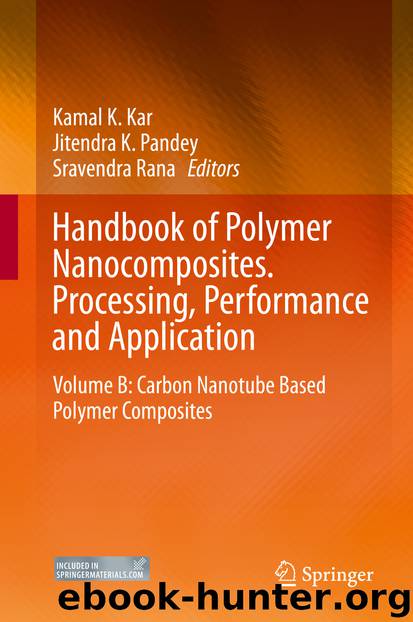Handbook of Polymer Nanocomposites. Processing, Performance and Application by Kamal K. Kar Jitendra K. Pandey & Sravendra Rana

Author:Kamal K. Kar, Jitendra K. Pandey & Sravendra Rana
Language: eng
Format: epub
Publisher: Springer Berlin Heidelberg, Berlin, Heidelberg
5 Crystallization of PEO in the Presence of Carbon Nanotubes
One of the most significant influences of nanoparticle incorporation in polymer matrices results from the convergence of relevant length scales that control the underlying physics of the structure and dynamics of such systems [2, 3]. In semicrystalline polymers, the average inter-nanoparticle distance is comparable or significantly smaller than the crystalline lamellae length scale, even at modest loadings of nanoparticles. As a consequence, the nanoparticles act as impenetrable objects and result in substantial changes in the polymer crystallization behavior. In this context, investigation of polymer crystallization in the presence of well-dispersed nanoparticles is an interesting and fundamental problem.
Carbon nanotubes are found to act as nucleating system for many families of semicrystalline polymers (such as poly(ε-caprolactone), poly(vinyl alcohol), poly(ethylene), poly(propylene), etc.) [17, 18, 117–120]. However, especially for poly(ethylene oxide), SWNTs are known to disturb the crystal formation and decrease the overall crystallinity of the system [33, 87, 121, 122]. Zhou and coworkers [87] first reported a decrease in PEO peak melting temperature from 72.0 °C to 65.0 °C in the presence of 10 wt% functionalized SWNTs for non-isothermal crystallization process. Below 6 wt% F-SWNTs loading, the nanocomposites behave homogeneously (a single PEO melting peak in non-isothermal DSC thermogram), but at higher loading phase, separation takes place which results in a low peak melting temperature (65 °C) for PEO chains in vicinity to the CNTs and a high peak melting temperature (72.3 °C) for the bulk PEO. Krishnamoorti and coworkers [33] reported DSC-based thermograms for non-isothermal heating and cooling with a decrease in area (i.e., decrease in fractional crystallinity) and a depression in the peak melting (T m,p ) and peak crystallization (T c,p ) temperature at low (0.05–0.5 vol%) SWNT loading (Fig. 13.8). Interestingly, wide-angle X-ray measurements (Fig. 13.9a) revealed that the PEO unit cell structures in these nanocomposites are preserved with little broadening of major reflection peaks indicating more disorder.
Fig. 13.8Melting (left) and crystallization (right) behavior for PEO and different nanocomposites for a constant heating (cooling) rate of 10 °C/min (Reprinted with permission from Ref. [33])
Download
This site does not store any files on its server. We only index and link to content provided by other sites. Please contact the content providers to delete copyright contents if any and email us, we'll remove relevant links or contents immediately.
| Automotive | Engineering |
| Transportation |
Whiskies Galore by Ian Buxton(41524)
Introduction to Aircraft Design (Cambridge Aerospace Series) by John P. Fielding(32883)
Small Unmanned Fixed-wing Aircraft Design by Andrew J. Keane Andras Sobester James P. Scanlan & András Sóbester & James P. Scanlan(32569)
Craft Beer for the Homebrewer by Michael Agnew(17927)
Turbulence by E. J. Noyes(7690)
The Complete Stick Figure Physics Tutorials by Allen Sarah(7135)
Kaplan MCAT General Chemistry Review by Kaplan(6589)
The Thirst by Nesbo Jo(6432)
Bad Blood by John Carreyrou(6270)
Modelling of Convective Heat and Mass Transfer in Rotating Flows by Igor V. Shevchuk(6219)
Learning SQL by Alan Beaulieu(6029)
Weapons of Math Destruction by Cathy O'Neil(5821)
Man-made Catastrophes and Risk Information Concealment by Dmitry Chernov & Didier Sornette(5641)
Digital Minimalism by Cal Newport;(5384)
Life 3.0: Being Human in the Age of Artificial Intelligence by Tegmark Max(5182)
iGen by Jean M. Twenge(5155)
Secrets of Antigravity Propulsion: Tesla, UFOs, and Classified Aerospace Technology by Ph.D. Paul A. Laviolette(4974)
Design of Trajectory Optimization Approach for Space Maneuver Vehicle Skip Entry Problems by Runqi Chai & Al Savvaris & Antonios Tsourdos & Senchun Chai(4837)
Electronic Devices & Circuits by Jacob Millman & Christos C. Halkias(4739)
